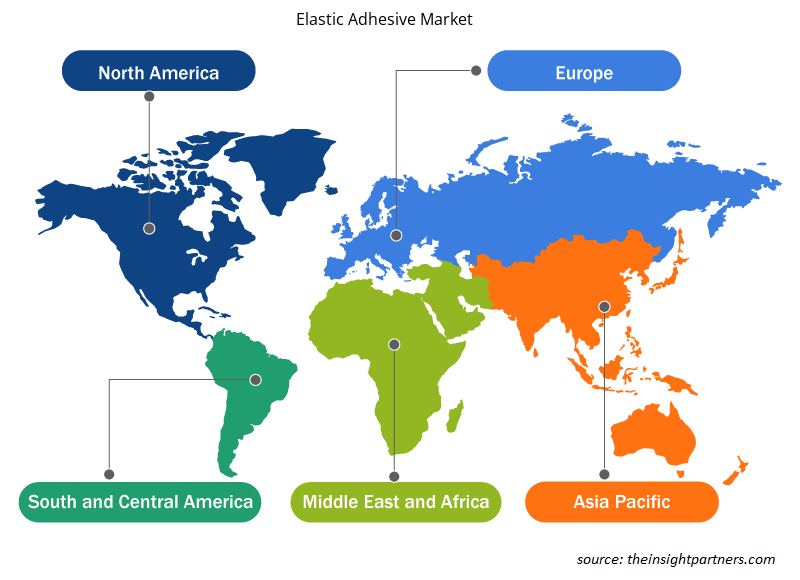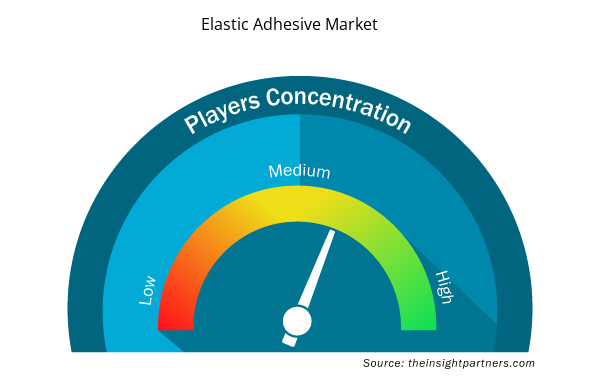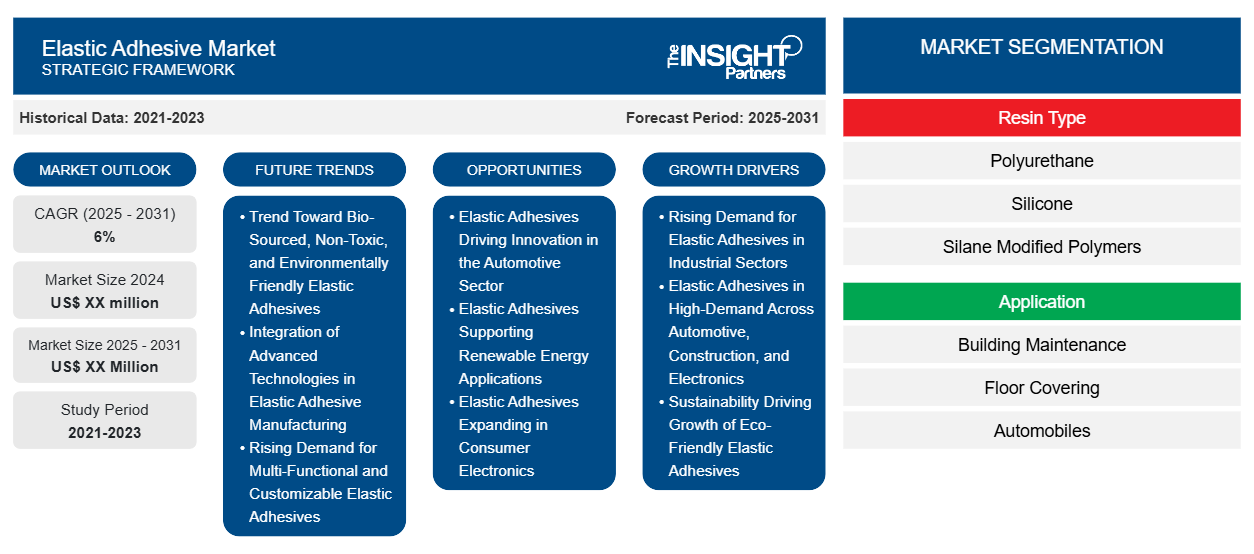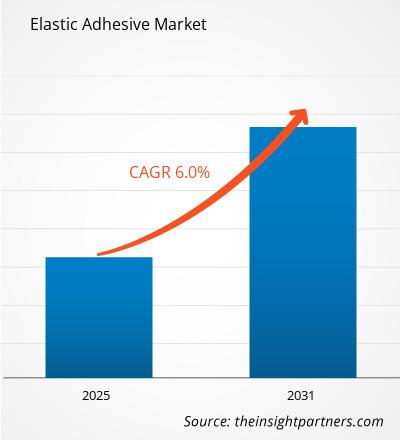Si prevede che il mercato degli adesivi elastici registrerà un CAGR del 6% dal 2023 al 2031, con una dimensione di mercato in espansione da XX milioni di dollari nel 2023 a XX milioni di dollari entro il 2031.
Il rapporto è segmentato per tipo di resina (poliuretano, silicone, polimeri modificati con silano (SMP), altri), applicazione (manutenzione edilizia, rivestimenti per pavimenti, automobili). Il rapporto presenta inoltre analisi basate sul settore di utilizzo finale (edilizia, automotive e trasporti, industriale). L'analisi globale è ulteriormente suddivisa a livello regionale e nei principali paesi. In termini geografici, il mercato è suddiviso in Nord America, Europa, Asia Pacifico, Medio Oriente e Africa e Sud e Centro America). Il rapporto offre il valore in USD per l'analisi e i segmenti di cui sopra.
Scopo del rapporto
Il report Elastic Adhesive Market di The Insight Partners mira a descrivere il panorama attuale e la crescita futura, i principali fattori trainanti, le sfide e le opportunità. Ciò fornirà spunti a vari stakeholder aziendali, come:
- Fornitori/produttori di tecnologia: per comprendere le dinamiche di mercato in evoluzione e conoscere le potenziali opportunità di crescita, consentendo loro di prendere decisioni strategiche informate.
- Investitori: condurre un'analisi completa delle tendenze relative al tasso di crescita del mercato, alle proiezioni finanziarie del mercato e alle opportunità esistenti lungo la catena del valore.
- Enti di regolamentazione: regolamentano le politiche e le attività di controllo sul mercato allo scopo di ridurre al minimo gli abusi, preservare la fiducia degli investitori e sostenere l'integrità e la stabilità del mercato.
Segmentazione del mercato degli adesivi elastici
Tipo di resina
- Poliuretano
- Silicone
- Polimeri modificati con silano
- Altri
Applicazione
- Manutenzione degli edifici
- Rivestimento del pavimento
- Automobili
Settore di utilizzo finale
- Costruzione
- Automotive e trasporti
- Industriale
Geografia
- America del Nord
- Europa
- Asia-Pacifico
- America del Sud e Centro
- Medio Oriente e Africa
Geografia
- America del Nord
- Europa
- Asia-Pacifico
- America del Sud e Centro
- Medio Oriente e Africa
Personalizza questo report in base alle tue esigenze
Riceverai la personalizzazione gratuita di qualsiasi report, comprese parti di questo report, o analisi a livello nazionale, pacchetto dati Excel, oltre a usufruire di grandi offerte e sconti per start-up e università
- Scopri le principali tendenze di mercato in questo rapporto.Questo campione GRATUITO includerà analisi di dati che spaziano dalle tendenze di mercato alle stime e alle previsioni.
Fattori di crescita del mercato degli adesivi elastici
- Domanda crescente di adesivi elastici nei settori industriali: gli adesivi elastici sono richiesti a causa della loro crescente applicazione in vari settori industriali come l'automotive, l'edilizia e l'elettronica. Gli adesivi elastici possono fornire eccellenti requisiti di resistenza di legame e flessibilità dei moderni processi di produzione, che sono resilienti per natura e durano a lungo.
- Adesivi elastici molto richiesti nei settori automobilistico, edile ed elettronico: il continuo aumento della domanda di legami potenti, ma flessibili e durevoli, in particolare nei settori automobilistico, edile ed elettronico, ha reso gli adesivi elastici alcuni degli adesivi più ampiamente utilizzati nelle applicazioni edilizie e automobilistiche per sigillatura, incollaggio e assemblaggio. Con lo sviluppo di questi settori dovuto alla crescita delle infrastrutture e della produzione di veicoli, la domanda di questi adesivi elastomerici aumenterà ulteriormente, travolgendo questo mercato.
- La sostenibilità guida la crescita degli adesivi elastici eco-compatibili: con la crescente domanda di prodotti eco-sostenibili, gli adesivi elastici eco-consapevoli sono destinati a crescere. I produttori stanno formulando adesivi a base d'acqua, non tossici e a basso contenuto di COV, conformi agli obiettivi di sostenibilità e agli standard normativi, diventando una forza trainante importante per l'espansione di questo mercato.
Tendenze future del mercato degli adesivi elastici
- Tendenza verso adesivi elastici di origine biologica, non tossici e rispettosi dell'ambiente: gli adesivi elastici derivati da fonti biologiche, non tossici e rispettosi dell'ambiente hanno guadagnato una tendenza a svilupparsi. Tutti i produttori mirano allo sviluppo dei loro materiali per sostenere le normative ambientali e la domanda dei consumatori per quelle alternative verdi e rinnovabili in modo da non fare troppo affidamento sui prodotti a base di petrolio.
- Integrazione di tecnologie avanzate nella produzione di adesivi elastici: una delle principali tendenze osservate nel mercato degli adesivi elastici è la crescente integrazione di tecnologie avanzate come l'automazione e la robotica. In particolare, queste nuove tecnologie miglioreranno la precisione, la velocità e la coerenza relative all'applicazione degli adesivi in vari settori come l'automotive, l'edilizia e l'elettronica, migliorando così la produttività e le prestazioni dei prodotti finali.
- Domanda crescente di adesivi elastici multifunzionali e personalizzabili: queste richieste stanno emergendo rapidamente nella richiesta dei consumatori di adesivi multifunzionali, ad esempio, rafforzamento del legame, resistenza all'acqua e flessibilità. Ciò porterà quindi alla realizzazione di adesivi elastici iperpersonalizzabili in risposta a particolari esigenze nei settori dell'imballaggio, automobilistico, dell'elettronica e altri settori simili, offrendo ai clienti soluzioni personalizzate per una varietà di applicazioni.
Opportunità di mercato degli adesivi elastici
- Adesivi elastici che guidano l'innovazione nel settore automobilistico: il settore automobilistico sta ora guardando a materiali leggeri per far sì che gli adesivi elastici sostituiscano le vecchie tecniche meccaniche per unire le parti. Questi adesivi forniscono legami forti e flessibili per l'assemblaggio dei componenti e di conseguenza aumentano l'efficienza del carburante e le prestazioni, traducendosi così in una maggiore domanda nella produzione automobilistica.
- Adesivi elastici a supporto delle applicazioni di energia rinnovabile: gli adesivi elastici si adatterebbero perfettamente a questo, poiché le fonti di energia rinnovabile, in particolare l'energia solare ed eolica, richiedono di aumentare la produzione. L'uso di adesivi elastici sarebbe ideale laddove i materiali sono legati all'interno di dispositivi a risparmio energetico, poiché flessibilità, alte prestazioni e durata sono necessarie per le applicazioni di energia rinnovabile.
- Adesivi elastici in espansione nell'elettronica di consumo: il mercato in forte espansione dell'elettronica di consumo promette grandi risultati per le applicazioni di adesivi elastici come l'incollaggio di schermi, l'assemblaggio di componenti elettronici e display flessibili, tra molti altri. Con questo, forniscono legami forti e duraturi in design compatti e flessibili e prestazioni molto migliori dei prodotti in un'applicazione elettronica, il che aumenta ulteriormente la crescita del mercato.
Approfondimenti regionali sul mercato degli adesivi elastici
Le tendenze regionali e i fattori che influenzano il mercato degli adesivi elastici durante il periodo di previsione sono stati ampiamente spiegati dagli analisti di Insight Partners. Questa sezione discute anche i segmenti e la geografia del mercato degli adesivi elastici in Nord America, Europa, Asia Pacifico, Medio Oriente e Africa e Sud e Centro America.

- Ottieni i dati specifici regionali per il mercato degli adesivi elastici
Ambito del rapporto di mercato degli adesivi elastici
| Attributo del report | Dettagli |
|---|---|
| Dimensioni del mercato nel 2023 | XX milioni di dollari USA |
| Dimensioni del mercato entro il 2031 | XX milioni di dollari USA |
| CAGR globale (2023-2031) | 6% |
| Dati storici | 2021-2022 |
| Periodo di previsione | 2024-2031 |
| Segmenti coperti | Per tipo di resina
|
| Regioni e Paesi coperti | America del Nord
|
| Leader di mercato e profili aziendali chiave |
|
Densità degli attori del mercato degli adesivi elastici: comprendere il suo impatto sulle dinamiche aziendali
Il mercato degli adesivi elastici sta crescendo rapidamente, spinto dalla crescente domanda degli utenti finali dovuta a fattori quali l'evoluzione delle preferenze dei consumatori, i progressi tecnologici e una maggiore consapevolezza dei vantaggi del prodotto. Con l'aumento della domanda, le aziende stanno ampliando le loro offerte, innovando per soddisfare le esigenze dei consumatori e capitalizzando sulle tendenze emergenti, il che alimenta ulteriormente la crescita del mercato.
La densità degli operatori di mercato si riferisce alla distribuzione di aziende o società che operano in un particolare mercato o settore. Indica quanti concorrenti (operatori di mercato) sono presenti in un dato spazio di mercato in relazione alle sue dimensioni o al valore di mercato totale.
Le principali aziende che operano nel mercato degli adesivi elastici sono:
- 3 milioni
- Arkema
- Pechino Comens Nuovi Materiali
- Cemedina
- Gruppo Celo
Disclaimer : le aziende elencate sopra non sono classificate secondo un ordine particolare.

- Ottieni una panoramica dei principali attori del mercato degli adesivi elastici
Punti di forza chiave
- Copertura completa: il rapporto copre in modo completo l'analisi di prodotti, servizi, tipologie e utenti finali del mercato degli adesivi elastici, fornendo una panoramica olistica.
- Analisi degli esperti: il rapporto è compilato sulla base della conoscenza approfondita di esperti e analisti del settore.
- Informazioni aggiornate: il rapporto garantisce la pertinenza aziendale grazie alla copertura di informazioni recenti e tendenze nei dati.
- Opzioni di personalizzazione: questo report può essere personalizzato per soddisfare le esigenze specifiche del cliente e adattarsi in modo appropriato alle strategie aziendali.
Il rapporto di ricerca sul mercato degli adesivi elastici può quindi aiutare a guidare il percorso di decodifica e comprensione dello scenario del settore e delle prospettive di crescita. Sebbene possano esserci alcune preoccupazioni valide, i vantaggi complessivi di questo rapporto tendono a superare gli svantaggi.
- Analisi storica (2 anni), anno base, previsione (7 anni) con CAGR
- Analisi PEST e SWOT
- Valore/volume delle dimensioni del mercato - Globale, regionale, nazionale
- Industria e panorama competitivo
- Set di dati Excel


- Employment Screening Services Market
- Mail Order Pharmacy Market
- Antibiotics Market
- Fish Protein Hydrolysate Market
- Sterilization Services Market
- Analog-to-Digital Converter Market
- Smart Mining Market
- Emergency Department Information System (EDIS) Market
- Frozen Potato Market
- Nuclear Waste Management System Market

Report Coverage
Revenue forecast, Company Analysis, Industry landscape, Growth factors, and Trends

Segment Covered
This text is related
to segments covered.

Regional Scope
North America, Europe, Asia Pacific, Middle East & Africa, South & Central America

Country Scope
This text is related
to country scope.
Domande frequenti
The report can be delivered in PDF/Word format, we can also share excel data sheet based on request.
Based on geography, North America held the largest share of the elastic adhesive market.
3M, Arkema S.A, Beijing Comens New Materials, Cemedine, Grupo Celo, Henkel, Mapei, Sika AG, Wacker Chemie, Weicon are the key players operating in the elastic adhesive market.
On the basis of geography, the elastic adhesives market is classified into North America, Europe, Asia Pacific, Middle East and Africa, and South and Central America.
The increasing need for strong, flexible, and durable bonds in industries like automotive, construction, and electronics is driving the demand for elastic adhesives.
The Elastic Adhesive Market is estimated to witness a CAGR of 6% from 2023 to 2031
Trends and growth analysis reports related to Chemicals and Materials : READ MORE..
1. 3M
2. Arkema
3. Beijing Comens New Materials
4. Cemedine
5. Grupo Celo
6. Henkel
7. Mapei
8. Sika AG
9. Wacker Chemie
10. Weicon
The Insight Partners performs research in 4 major stages: Data Collection & Secondary Research, Primary Research, Data Analysis and Data Triangulation & Final Review.
- Data Collection and Secondary Research:
As a market research and consulting firm operating from a decade, we have published and advised several client across the globe. First step for any study will start with an assessment of currently available data and insights from existing reports. Further, historical and current market information is collected from Investor Presentations, Annual Reports, SEC Filings, etc., and other information related to company’s performance and market positioning are gathered from Paid Databases (Factiva, Hoovers, and Reuters) and various other publications available in public domain.
Several associations trade associates, technical forums, institutes, societies and organization are accessed to gain technical as well as market related insights through their publications such as research papers, blogs and press releases related to the studies are referred to get cues about the market. Further, white papers, journals, magazines, and other news articles published in last 3 years are scrutinized and analyzed to understand the current market trends.
- Primary Research:
The primarily interview analysis comprise of data obtained from industry participants interview and answers to survey questions gathered by in-house primary team.
For primary research, interviews are conducted with industry experts/CEOs/Marketing Managers/VPs/Subject Matter Experts from both demand and supply side to get a 360-degree view of the market. The primary team conducts several interviews based on the complexity of the markets to understand the various market trends and dynamics which makes research more credible and precise.
A typical research interview fulfils the following functions:
- Provides first-hand information on the market size, market trends, growth trends, competitive landscape, and outlook
- Validates and strengthens in-house secondary research findings
- Develops the analysis team’s expertise and market understanding
Primary research involves email interactions and telephone interviews for each market, category, segment, and sub-segment across geographies. The participants who typically take part in such a process include, but are not limited to:
- Industry participants: VPs, business development managers, market intelligence managers and national sales managers
- Outside experts: Valuation experts, research analysts and key opinion leaders specializing in the electronics and semiconductor industry.
Below is the breakup of our primary respondents by company, designation, and region:

Once we receive the confirmation from primary research sources or primary respondents, we finalize the base year market estimation and forecast the data as per the macroeconomic and microeconomic factors assessed during data collection.
- Data Analysis:
Once data is validated through both secondary as well as primary respondents, we finalize the market estimations by hypothesis formulation and factor analysis at regional and country level.
- Macro-Economic Factor Analysis:
We analyse macroeconomic indicators such the gross domestic product (GDP), increase in the demand for goods and services across industries, technological advancement, regional economic growth, governmental policies, the influence of COVID-19, PEST analysis, and other aspects. This analysis aids in setting benchmarks for various nations/regions and approximating market splits. Additionally, the general trend of the aforementioned components aid in determining the market's development possibilities.
- Country Level Data:
Various factors that are especially aligned to the country are taken into account to determine the market size for a certain area and country, including the presence of vendors, such as headquarters and offices, the country's GDP, demand patterns, and industry growth. To comprehend the market dynamics for the nation, a number of growth variables, inhibitors, application areas, and current market trends are researched. The aforementioned elements aid in determining the country's overall market's growth potential.
- Company Profile:
The “Table of Contents” is formulated by listing and analyzing more than 25 - 30 companies operating in the market ecosystem across geographies. However, we profile only 10 companies as a standard practice in our syndicate reports. These 10 companies comprise leading, emerging, and regional players. Nonetheless, our analysis is not restricted to the 10 listed companies, we also analyze other companies present in the market to develop a holistic view and understand the prevailing trends. The “Company Profiles” section in the report covers key facts, business description, products & services, financial information, SWOT analysis, and key developments. The financial information presented is extracted from the annual reports and official documents of the publicly listed companies. Upon collecting the information for the sections of respective companies, we verify them via various primary sources and then compile the data in respective company profiles. The company level information helps us in deriving the base number as well as in forecasting the market size.
- Developing Base Number:
Aggregation of sales statistics (2020-2022) and macro-economic factor, and other secondary and primary research insights are utilized to arrive at base number and related market shares for 2022. The data gaps are identified in this step and relevant market data is analyzed, collected from paid primary interviews or databases. On finalizing the base year market size, forecasts are developed on the basis of macro-economic, industry and market growth factors and company level analysis.
- Data Triangulation and Final Review:
The market findings and base year market size calculations are validated from supply as well as demand side. Demand side validations are based on macro-economic factor analysis and benchmarks for respective regions and countries. In case of supply side validations, revenues of major companies are estimated (in case not available) based on industry benchmark, approximate number of employees, product portfolio, and primary interviews revenues are gathered. Further revenue from target product/service segment is assessed to avoid overshooting of market statistics. In case of heavy deviations between supply and demand side values, all thes steps are repeated to achieve synchronization.
We follow an iterative model, wherein we share our research findings with Subject Matter Experts (SME’s) and Key Opinion Leaders (KOLs) until consensus view of the market is not formulated – this model negates any drastic deviation in the opinions of experts. Only validated and universally acceptable research findings are quoted in our reports.
We have important check points that we use to validate our research findings – which we call – data triangulation, where we validate the information, we generate from secondary sources with primary interviews and then we re-validate with our internal data bases and Subject matter experts. This comprehensive model enables us to deliver high quality, reliable data in shortest possible time.


 Ottieni un campione gratuito per questo repot
Ottieni un campione gratuito per questo repot